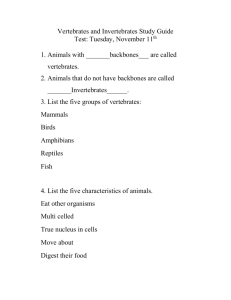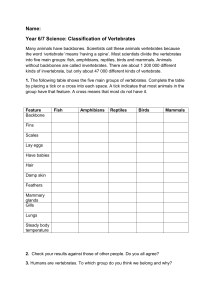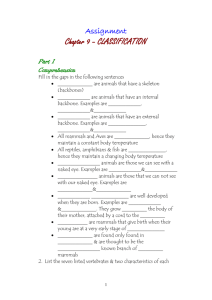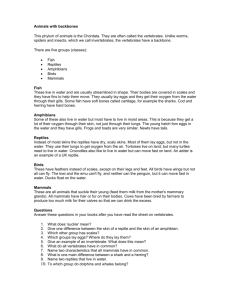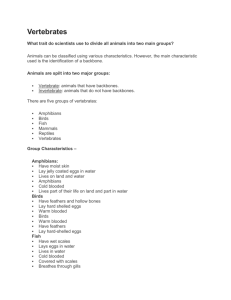VERTEBRATES AND INVERTEBRATES
advertisement
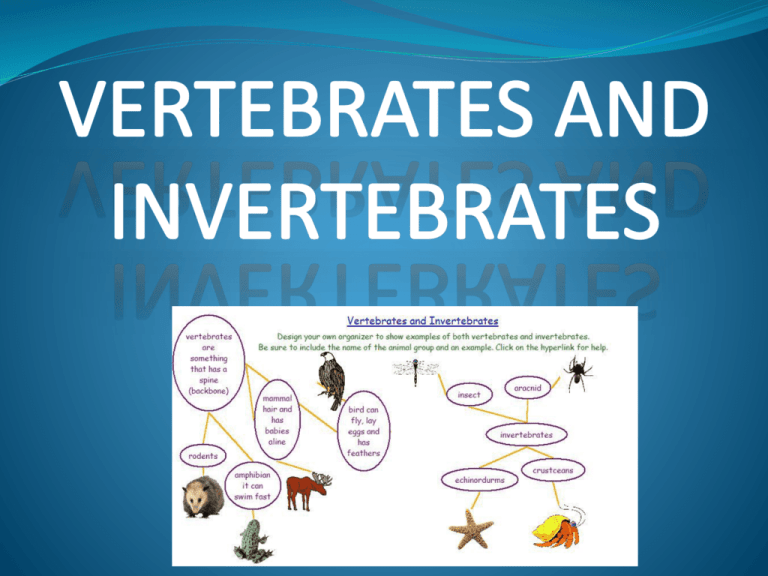
All animal can be classified as belonging to one of two groups: Those with backbones Those without backbones Animals without backbones are called Invertebrates There are many different types of invertebrates: Sponges Are simple animals Have no backbone Anemones and Jellyfish Have tentacles and stinging cells All live in water Feed themselves with their tentacles Have no backbone Worms Snails, clams and octopuses Often have shells Have a head, foot and well developed organs Have no backbone Starfish and Urchins Have a spiny body Live on the bottom of the Ocean Have no backbone Insect, Spiders, Ticks, Lobsters, Crabs and Crayfish Have a shell like covering called an exoskeleton Have joined legs. Have a segmented body Animals with backbones are called Vertebrates There are five groups of vertebrates: Fish Are cold-blooded Live in water Have backbone These are fish: Fish have backbone: Reptiles Have scales Live on land Are cold-blooded Usually lay eggs Have backbone These are reptiles: Reptiles have backbones: Amphibians Are cold blooded Live on land and in water Have smooth skin Lay eggs These are amphibians Amphibians have backbone: Birds Have feathers Are warm-blooded Have hollow bones and most can fly Lay eggs Birds have backbone: Mammals Have hair or fur Are warm-blooded Feed milk to their young Bear live young (except monotremes) Mammals have backbones Vertebrates Invertebrates Animals without a Backbone or Spinal Column: Animals with a Backbone or Spinal Column: (All these animals are in the phyla Chordata and the subphyla Vertebrata.) Animals with an internal skeleton made of bone are called vertebrates. Vertebrates include fish, amphibians, reptiles, birds, mammals, primates, rodents and marsupials. Although vertebrates represent only a very small percentage of all animals, their size and mobility often allow them to dominate their environment. Click on the picture or name of the animals below for more information. Fish Amphibians Reptiles Mammals Primates Rodents Marsupials Whales and Dolphins Seals Mammals Molluscs Birds Worms Reptiles Arthropods Amphibians Echinoderms Fish Coelenterates We are vertebrates and have a skeleton to keep us upright and to help us to move. MAMMALS VERTEBRATES ARE ANIMALS WITH BACKBONES Warm blooded vertebrate animals which have hair or fur. Retain the young in their bodies until they are ready to be born. When the young are born they are fed by the mother on milk. Mammals have a highly developed nervous system. They live on land and in the sea. There is a very wide range of types in this group. The largest mammal is the blue whale which often exceeds 30m in length. Shrews, mice and mice which are the smallest are often less than 5cm, excluding their tail. Human beings are mammals. BIRDS Warm blooded vertebrate animals with wings and bodies covered with feathers for warmth and to help them to fly. Birds have lungs for breathing and a heart with four chambers. All adult birds are covered in feathers even though some are born naked. The female lays the eggs and the young hatch from these. The young are cared for by the adult birds until they are old enough to fend for themselves. The female lays the eggs and the young hatch from these. The young are cared for by the adult birds until they are old enough to fend for themselves. REPTILES Cold blooded vertebrates. This means they cannot maintain a body temperature much different than their environment. Most reptiles lay eggs with hard shells. Young fully formed reptiles hatch from the eggs. Reptiles usually lay their eggs in sand. Some snakes and lizards retain their eggs in their body and give birth to live young. Young reptiles have to care for themselves from the time they hatch. A reptile's skin is usually covered with scales. Reptiles have been on earth for over 300 million years - that is a very long time! AMPHIBIANS Cold blooded vertebrate animals that generally spend their larval or tadpole stage in fresh water. They do not transfer to the land until they are mature, returning to the water to breed. Amphibians were the first animals to venture on to land. They emerged from the oceans over 300 million years ago. Frogs, toads and salamanders are amphibians. venture on to land. They emerged from the oceans over 300 million years ago. Frogs, toads and salamanders are amphibians. FISH Cold blooded vertebrate animals that live in water and use gills to obtain oxygen. Fish live in both fresh and salt water and can be found all over the world, except in some very hot larval springs and the Dead Sea because it is too salty. Of the million or more animal species in the world, more than 98% are invertebrates. Invertebrates don't have an internal skeleton made of bone. Many invertebrates have a fluid-filled, hydrostatic skeleton, like the jelly fish or worm. Others have a hard outer shell, like insects and crustaceans. There are many types of invertebrates. The most common invertebrates include the protozoa, annelids, echinoderms, mollusks and arthropods. Arthropods include insects, crustaceans and arachnids. Protozoa Annelids Mollusks Crustaceans Arachnids Insects Echinoderms WORMS These are animals whose bodies are divided into a number of similar rings. The head tapers to a point. The tail is broad and flat. Pores on the skin cover its body with slime. This slime keeps the worm clean, makes it slippery and kills germs. The pointed nose drills into the soil and the flat tail presses it tight. The slime is then used to cement the burrows. ECHINODERMS Echinoderm is a common name for about 6 000 living species that live at all depths in all of the oceans of the world . These include: Starfish, sea-cucumbers and sea-urchins. Starfish have a mouth surrounded by 5 arms. At the ends of the arms are fleshy tube feet which the starfish uses to cling to things and to crawl about. Sea-urchins have spines that are very well developed. Echinoderms have simple nervous and circulatory systems. This is the common name for 9 000 species of invertebrate animals found in all oceans of the world. These include: Coral, jellyfish and sea-anenome. Some are cylindrical with the mouth and tentacles at one end. Jellyfish look like an opened umbrella with tentacles hanging. All coelenterates capture their prey in the tentacles and then kill them with poison from the stinging organ.

